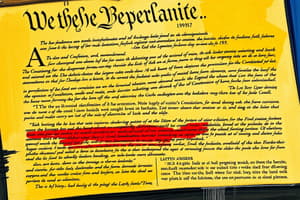Podcast
Questions and Answers
Basic ___________, or laws, are outlined in the Constitution.
Basic ___________, or laws, are outlined in the Constitution.
principles/rule
Soon after the Constitution became effective, ________ amendments were added.
Soon after the Constitution became effective, ________ amendments were added.
17
How many amendments does the Constitution have?
How many amendments does the Constitution have?
27
Article ______ says the Constitution is the law of the land.
Article ______ says the Constitution is the law of the land.
The idea that the federal government gets its power from ____ _________ is called popular sovereignty.
The idea that the federal government gets its power from ____ _________ is called popular sovereignty.
Limited government means that the government is never ________ the law.
Limited government means that the government is never ________ the law.
Government must follow the principles authorized by the people. This is the _________ of __________.
Government must follow the principles authorized by the people. This is the _________ of __________.
The division of government into three ___________ is called the separation of powers.
The division of government into three ___________ is called the separation of powers.
The Constitution states that only ______________ can make laws.
The Constitution states that only ______________ can make laws.
The President cannot make laws, but must __________ all laws passed by Congress.
The President cannot make laws, but must __________ all laws passed by Congress.
Congress can ____________ the President's veto.
Congress can ____________ the President's veto.
Courts can decide whether or not actions of the government are ____________________. This power is called judicial review.
Courts can decide whether or not actions of the government are ____________________. This power is called judicial review.
Federalism is a system of government in which power is divided between a _____________ ____________ and _______________ governments.
Federalism is a system of government in which power is divided between a _____________ ____________ and _______________ governments.
One way to make a change to the Constitution is for two-thirds of the members of _____________ to approve an amendment.
One way to make a change to the Constitution is for two-thirds of the members of _____________ to approve an amendment.
In our federal system, three-fourths of the ______________ _________________ must approve an amendment for it to become part of the Constitution.
In our federal system, three-fourths of the ______________ _________________ must approve an amendment for it to become part of the Constitution.
The first _____ amendments to the Constitution are known as the Bill of Rights.
The first _____ amendments to the Constitution are known as the Bill of Rights.
The ________ Amendment limited a President to two full terms in office.
The ________ Amendment limited a President to two full terms in office.
The 27th Amendment was first proposed in ________ but was not ratified until _________.
The 27th Amendment was first proposed in ________ but was not ratified until _________.
__________ passed by Congress have helped shape the basic framework of the Constitution.
__________ passed by Congress have helped shape the basic framework of the Constitution.
Presidents have brought about constitutional change by making ______________ agreements with leaders of foreign countries.
Presidents have brought about constitutional change by making ______________ agreements with leaders of foreign countries.
The Supreme Court ______________ the Constitution as it hears and decides cases.
The Supreme Court ______________ the Constitution as it hears and decides cases.
Many of the Framers disliked the idea of political parties. Despite this fact, much of American government today is conducted on the basis of ___________.
Many of the Framers disliked the idea of political parties. Despite this fact, much of American government today is conducted on the basis of ___________.
One way parties have brought about constitutional change is by taking over the selection of candidates for the _____________ and ____________.
One way parties have brought about constitutional change is by taking over the selection of candidates for the _____________ and ____________.
The Constitution does not mention the President's _____________, his group of advisors. Instead, it came about through tradition and custom.
The Constitution does not mention the President's _____________, his group of advisors. Instead, it came about through tradition and custom.
Some customs were followed for years before being written into the Constitution, such as the -__-_______ tradition.
Some customs were followed for years before being written into the Constitution, such as the -__-_______ tradition.
Flashcards are hidden until you start studying
Study Notes
Key Principles of the Constitution
- Basic laws and principles are established in the Constitution.
- The Constitution includes a total of 27 amendments, with 17 added shortly after its enactment.
Constitution as Supreme Law
- Article VI of the Constitution establishes it as the law of the land, reinforcing its supremacy.
Core Concepts of Governance
- Popular sovereignty is the principle that the government's power comes from the people.
- Limited government ensures that no entity is above the law, adhering to the rule of law.
Separation of Powers
- The government is divided into three branches: legislative, executive, and judicial, known as separation of powers.
- Only Congress, the legislative branch, has the authority to make laws, while the President enforces them.
Checks and Balances
- Congress can override a Presidential veto, providing a check on the executive branch.
- The judiciary holds the power of judicial review, assessing whether government actions are unconstitutional.
Federalism
- Federalism divides power between a central government and regional governments, allowing for shared authority.
Amending the Constitution
- An amendment requires approval from two-thirds of Congress and ratification by three-fourths of state legislatures.
- The first ten amendments constitute the Bill of Rights, guaranteeing fundamental freedoms.
Presidential Terms and Amendments
- The 22nd Amendment limits the President to two full terms in office.
- The 27th Amendment was proposed in 1789 but ratified only in 1992.
Laws and Constitutional Development
- Laws passed by Congress contribute to shaping the Constitution's framework.
- Presidents can influence constitutional change through executive agreements with foreign leaders.
Judicial Interpretation
- The Supreme Court interprets the Constitution as it adjudicates cases, ensuring its application evolves with society.
Political Parties and Customs
- Despite early opposition to political parties by the Framers, party politics plays a significant role in American governance today.
- The Constitution does not mention the President's Cabinet, which has developed through tradition.
- The no-third-term tradition, followed for years, is an example of a custom that influenced constitutional practice.
Studying That Suits You
Use AI to generate personalized quizzes and flashcards to suit your learning preferences.




